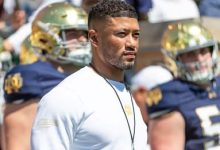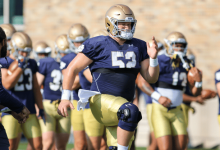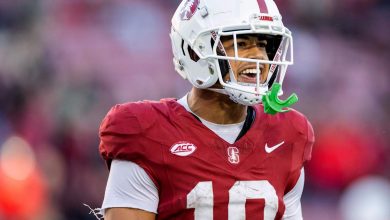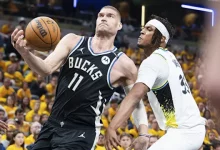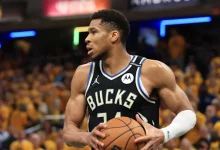The Reason Kevin Durant Joined the Warriors in 2016

The Reason Kevin Durant Joined the Warriors in 2016: A Defining Moment in NBA History
The year 2016 is etched into NBA history for a multitude of reasons. The Cleveland Cavaliers famously came back from a 3-1 deficit to win the NBA Finals against the Golden State Warriors, delivering the city of Cleveland its first major sports championship in over 50 years. However, another seismic event that took place during that summer would shape the course of the NBA for years to come: Kevin Durant, one of the league’s best players, decided to leave the Oklahoma City Thunder and join the Warriors, a team that had just set the NBA record for wins in a single season.
Durant’s decision to join Golden State was met with mixed reactions. Many praised him for seeking a championship opportunity, while others criticized him for joining a team that had already been dominant, arguing that it undermined the competitive spirit of the game. Regardless of the public reaction, Durant’s move to the Warriors was a pivotal moment in NBA history that altered the trajectory of both his career and the league as a whole. To understand why Durant made this controversial decision, one must delve into his personal motivations, his basketball career up until that point, the dynamics of the Warriors’ success, and the broader context of the NBA during that era.
The Road to Free Agency: Durant’s Journey in Oklahoma City
Kevin Durant’s path to free agency in 2016 was a product of years of growth and frustration. Durant was drafted by the Seattle SuperSonics in 2007 as the second overall pick, before the franchise relocated to Oklahoma City and became the Thunder. Durant quickly established himself as one of the league’s top players, winning the NBA Rookie of the Year award and earning multiple All-Star selections in his early seasons. Along with fellow young stars Russell Westbrook and James Harden, Durant helped lead the Thunder to perennial playoff contention.
In 2012, the Thunder reached the NBA Finals, but were defeated by the Miami Heat in five games. It was a painful loss, but the team was young, and the future seemed bright. Durant continued to improve, winning the 2014 MVP award after an outstanding season in which he averaged 32 points, 7.4 rebounds, and 5.5 assists per game.
However, despite his individual success, Durant was unable to lead the Thunder to an NBA championship. The team’s inability to overcome their biggest obstacles in the playoffs – notably, the Miami Heat in 2012, and the Golden State Warriors in 2016 – began to weigh heavily on Durant. The Thunder had an explosive roster but struggled with consistency and meshing the styles of its star players, particularly Westbrook and Durant. While the team remained competitive, Durant’s frustration mounted as the Thunder’s playoff runs ended in heartbreak.
The 2016 Western Conference Finals were a turning point. Durant and the Thunder found themselves in a commanding 3-1 lead over the Warriors, the defending NBA champions, in a series that appeared to be in Oklahoma City’s control. But then, the Warriors mounted one of the most remarkable comebacks in NBA history, winning the final three games of the series to eliminate the Thunder. For Durant, the loss was devastating. It seemed as if his best chance at winning an NBA championship had slipped away.
The collapse of the Thunder and Durant’s growing realization that his chances of winning a title in Oklahoma City were slim led him to consider leaving the team in search of a better opportunity.
The Golden State Warriors: A Dominant Team
The Golden State Warriors, on the other hand, were in the midst of one of the greatest seasons in NBA history. During the 2015-2016 season, the Warriors set an NBA record with 73 wins, breaking the previous mark held by the 1995-96 Chicago Bulls. Under the guidance of head coach Steve Kerr, the Warriors were a team defined by their ball movement, spacing, and prolific three-point shooting. The Warriors’ success was largely driven by two players: Stephen Curry, who was in the midst of an MVP season, and Klay Thompson, one of the league’s best shooters.
Golden State’s rise to prominence had been swift. The Warriors’ transformation from a middle-of-the-pack team to a legitimate championship contender came in large part due to their innovative style of play, centered around the “Splash Brothers” and their three-point shooting, which revolutionized the game. The team’s ability to play fast and space the floor allowed them to dominate offensively while also remaining sound defensively.
But what made the Warriors especially dangerous was their depth. Along with Curry and Thompson, the Warriors boasted key contributors such as Draymond Green, who provided elite defense, playmaking, and leadership, and Andre Iguodala, who played a crucial role off the bench. The team’s chemistry was undeniable, and the synergy between their stars made them one of the most difficult matchups in the history of the NBA.
In the 2015 Finals, the Warriors defeated the Cleveland Cavaliers in six games to win their first championship in 40 years. While they were considered the team to beat in the league, their 2016 season solidified them as one of the best teams of all time.
However, despite their dominance in the regular season and the previous year’s championship, the Warriors had come up short in the 2016 Finals against LeBron James and the Cavaliers. After building a 3-1 lead, Golden State collapsed in the final three games, allowing Cleveland to secure the title. The Warriors’ defeat in the 2016 Finals left them with a bitter taste in their mouths and a desire to redeem themselves the following season.
Durant’s Decision to Join the Warriors: A Controversial Move
When the free agency period arrived in 2016, Durant’s decision to leave Oklahoma City was anticipated, but where he would go was a source of constant speculation. Several teams made a push for Durant, but it quickly became clear that the Warriors were the frontrunners. Golden State had the cap space to sign him, and the team was coming off a disappointing loss in the Finals, which only made Durant’s decision more enticing. Joining the Warriors meant that Durant would be adding himself to a team that had already been successful but was still looking for redemption after the Finals loss.
For Durant, the opportunity to join a team that already had elite players like Curry, Thompson, and Green was incredibly appealing. The Warriors were already a championship contender, and adding Durant to their mix would make them almost unbeatable. The chance to play alongside some of the best shooters in NBA history and to benefit from the team’s unselfish style of play was too good to pass up.
Durant’s decision was also influenced by his own desire to win a championship. While he had been an individual success story in Oklahoma City, he knew that his best chance to win a title was with the Warriors. The 2016 Finals loss to the Cavaliers had cemented in his mind that he needed a better supporting cast if he was going to secure his first ring. Durant had previously tried to carry his team on his back, but with the Warriors, he would have the luxury of playing in a system that maximized his strengths while also allowing him to take a backseat when necessary.
Critics, however, were quick to label Durant’s move as weak or as a “cupcake” move, arguing that he was joining an already stacked team instead of competing against them. Many fans and pundits questioned Durant’s legacy, wondering whether he would truly earn the respect he craved if he won a championship with the Warriors. Others believed that Durant’s decision was a reflection of the changing dynamics of the NBA, where superteams were becoming more prevalent and players were increasingly focused on their own legacies.
The Aftermath: Success and Legacy
Durant’s decision to join the Warriors paid immediate dividends. In his first season with the team, the Warriors went 67-15, and Durant helped lead them to an NBA title. The Warriors defeated the Cleveland Cavaliers in five games in the 2017 Finals, with Durant being named Finals MVP after an incredible series in which he averaged 35.2 points, 8.2 rebounds, and 5.4 assists per game. Durant’s clutch performances, including a memorable three-pointer over LeBron James in the closing minutes of Game 3, helped seal the championship.
Durant would go on to win another title with the Warriors in 2018, further cementing his place in NBA history. However, despite the success, the decision to join Golden State remained a point of contention. Some fans and analysts still viewed Durant’s championships with an asterisk, arguing that his move to the Warriors was not a fair competition. Durant, however, maintained that he was simply trying to win and that his decision was about seeking the best opportunity for himself and his career.
In the years following his time with Golden State, Durant moved on to the Brooklyn Nets, but the legacy of his time with the Warriors remains a topic of discussion. Durant helped the Warriors become one of the most dominant teams in NBA history, and his time in Golden State ultimately helped him achieve the championships and recognition he sought.
Durant’s decision to join the Warriors marked the beginning of a new era in the NBA, one where superstars were not afraid to join forces to maximize their chances at winning titles. It raised questions about the nature of competition in the league and the role of team-building in creating championship contenders.

